#Luxury
Review: 2014 Lexus GS 450h
Last time TTAC looked at the Lexus GS Hybrid, Jack and I descended upon Vegas, drank too much, shared too much and one of us got purse-slapped (it wasn’t Jack). In other news, Jack found the GS a willing partner on the track, I kept drawing comparisons to the Volvo S80 T6 and Hyundai Genesis, and both of us agreed the GS 450h would be the car we’d buy. Despite telling you all that we would have a full review in “a few months,” it has in fact been “a few years.” Since that pair of articles hit, the luxury hybrid landscape has changed dramatically.
First Drive Review: 2015 Volvo V60 T5 Sport Wagon (With Video)
There was a time when wagons roamed the interstates, ferrying families from one National Lampoon vacation to another. With the rise of the crossover, those looking for the original “looks practical but handles like a sedan” mode of transport have few options, and most of them live in the luxury segment. Let’s count them before we go too far. We have the soon-to-be-cancelled Acura TSX, the last-generation Cadillac CTS , the Volkswagen Jetta, Mercedes-Benz E-Class, BMW 3-Series and the Toyota Prius V. Even if you expand things to include “off-road wagons”the list only grows by three (Audi Allroad, Subaru Outback and Volvo XC70.) Despite the shrinking market, Volvo’s brand has long been associated with practical wagons. It’s almost hard to believe it has been three full years since Volvo sold one in America. That’s about to change with the 2015 V60.
Review: 2014 Buick Regal GS AWD (With Video)
In my mind, Volkswagens used to be the “Euro Buick.” Positioned one note above the mass market rabble, VW’s Passat shared parts with Audi’s A4, while the Touareg and Phaeton were luxury cars with a mass market logo on the hood. Then Volkswagen decided this was the wrong strategy for them, so they repositioned VW as the German alternative to Toyota and Chevrolet. This left a gaping hole in the market for shoppers looking to step into a European near-luxury vehicle that flew under the radar. And then Buick stepped in.Buick’s Opel-based product offensive has transformed the brand from Barcalounger wheels for the octogenarian, to a window into the soul of GM’s German brand. This transformation isn’t an easy one as Buick’s problem wasn’t just blue-haired buyers and slinky-soft springs. Buick is the penultimate middle child. Jammed between Chevrolet and Cadillac, brand B’s mission is to give Chevy buyers something to aspire to and Cadillac buyers something to graduate from.
In Defense Of: The Acura RLX
“There aren’t many bad cars on the market,” is the trope trotted out by auto reviewers when justifying their enthusiastic response to whatever is trotted out in front of them at the Lowes Santa Monica on Wave 2 of the latest press launch. The post-recession era is one where the quality of the average car has never been higher, at the expense of idiosyncratic flaws that give cars character. Sure, there are always the whipping boys of the market, namely cars people actually buy like unibody crossovers and some that people don’t, like big, front-drive sedans.
Piston Slap: The Fiesta's Rocky Road Ahead?
Clark writes:
Hello Sajeev,
I currently drive a 2007 G35S that works great and has been dead nuts reliable since I bought it lightly used a couple of years ago. It also works just fine for my duties of pickup/drop off of my toddler at daycare. Despite being plenty quick, it’s kind of dull. I really miss having a daily driver that doubles as an autocross/occasional track-day car.
A few weeks back I attended a ford ecoboost event and got to hustle a Fiesta ST around an autocross course. I was pretty impressed and now I’m strongly considering switching over. I also like that it gets ~50% better fuel economy and the 17″ wheels mean cheaper replacement tires than the staggered 18″ setup on the G35 (plus, I think I may be harder on tires than most). Lower running costs wouldn’t hurt my feelings one bit.
Review: 2014 Cadillac CTS 2.0T (With Video)
It’s been decades since Cadillac produced the “Cadillac” of anything. However, when car buffs dismiss the only American luxury brand left, they fail to see Cadillac’s march forward. 2002 brought the first RWD Cadillac since the Fleetwoood. A year later the XLR roadster hit, followed in 2004 by Cadillac’s first 5-Series fighter, the STS. Not everything was rosy. The original CTS drove like a BMW but lacked charm and luxury fittings. The XLR was based on a Corvette, which made for excellent road manners, but the Northstar engine didn’t have the oomph. The STS sounded like a good idea, but the half-step CTS wasn’t much smaller and ultimately shoppers weren’t interested in a bargain option. That brings us to the new ATS and CTS. Ditching the “more car for less money” mantra, the ATS has been created to fight the C/3/IS leaving the CTS free to battle the E/5/GS head-on. Can Caddy’s sensible new strategy deliver the one-two punch fans have hoped for? I snagged a CTS 2.0T for a week to find out.
First Drive Review: 2014 Acura RLX Sport Hybrd (With Video)
It wasn’t that long ago I had an Acura RLX for a week. If you recall that review, I came away liking the car but found little joy in the price tag. Despite wearing a fantastic stitched leather interior, there was just no way I could justify the $10,000 premium over the AWD turbocharged competition from Lincoln, Volvo and others. Can a new dual clutch transmission and three electric motors turn the RLX from being a good car with the wrong price tag to a value proposition?
Cain's Segments: Luxury Flagships
As expected, the arrival of Mercedes-Benz’s sixth-generation S-Class provided a massive boost in sales just as Mercedes-Benz’s all-new CLA-Class arrived at the bottom of the lineup. Traditionally seen as the market leader, the S-Class has attempted to put aside all doubts by attracting more than 1900 U.S. buyers in each of the last two months. It’s popular.
QOTD: Better Off Mainstream?
Speaking at a preview event for the next-generation Hyundai Genesis, Hyundai CEO John Krafcik defended his company’s decision to forgo establishing a seperate luxury channel for cars like the Genesis and Equus. While the rationale put forth usually revolves around the exorbitantly expensive pricetag for launching a new brand and an all-new sales network, Krafcik put it from another angle.
Whither Volvo?
I’ve always had a soft spot for Volvo, that’s probably why I’ve owned two and chose European Delivery on one of them. But Volvo has a problem. It’s not the product. It’s not even the brand positioning. It’s a lack of advertising and visibility. Let’s dive deep into my mind as I pontificate about Volvo’s destiny.
Review: 2014 Buick Enclave (With Video)
I’ve dished out plenty of Buick love lately. The Verano beats Acura and Lexus at the entry-luxury game and the tiny Encore is an oddly attractive (albeit underpowered) crossover that is outselling the Mini Countryman and Range Rover Evoque by a wide margin. What can we attribute this sales success to? I posit that the original Buick Enclave is the impetus. Landing in 2007 as a 2008 model, it was the poster child of the “new Buick.” On the surface, the Enclave was the replacement for the Buick Rainier, the only GMT360 SUV I haven’t owned. (Just kidding, I’ve only owned 2 of the 11 varieties.) But that’s a simplistic view. In reality the Enclave was intended to elevate the brand enough to compete with three row luxury crossovers from Germany and Japan. This brings us to today’s question: six years and a mild face-lift later, does the Buick still have the goods?
Review: 2014 Acura ILX 2.4 (With Video)
The Acura ILX has been derided as being nothing more than a gussied-up Honda Civic, an analogy that I too applied to the compact Acura when it first arrived. But then our own Brendan McAleer caused me to question my dismissal of the ILX. How many shoppers out there are willing to option-up a base model by 50% and don’t think twice about the fact their “limited” model looks just like the base model? All of a sudden the ILX, especially the 2.4L model we tested made sense to me. What was the revelation? Click through the jump to find out.
Review: 2014 Lexus LS 600hL (With Video)
The LS 600hL is the pinnacle of Toyota and Lexus engineering. It is the largest Lexus sedan, the brand’s most expensive model, the most expensive hybrid in the world and, with the death of BMW’s V8 ActiveHybrid system, it is once again the most powerful hybrid on sale. Yet the LS 600hL hasn’t had an easy time of things. The large luxury sedan has been lambasted for being the antithesis of green thanks to its EPA combined 20 MPG score. Critics also question whether the 600hL’s enormous premium over the LS 460L can ever be “justified.” I too questioned the logic behind the 600hL at first, but then I spoke with someone who changed my mind. Before we dive in, let’s talk about the elephant in the room. The 600hL starts at $119,910. With all the options checked, you land at $134,875. Without destination. Put your eye balls back in their sockets and click past the jump as we dive into an alternate universe.
Cain's Segments: Midsize Luxury Vehicles
Mercedes-Benz E-Class sales shot up 44% in August 2013, a 2008-unit gain. This improvement followed up on July’s 10% year-over-year improvement, which put an end to four consecutive months of decline for the now-recently facelifted E-Class, Mercedes-Benz’s core midsize model.







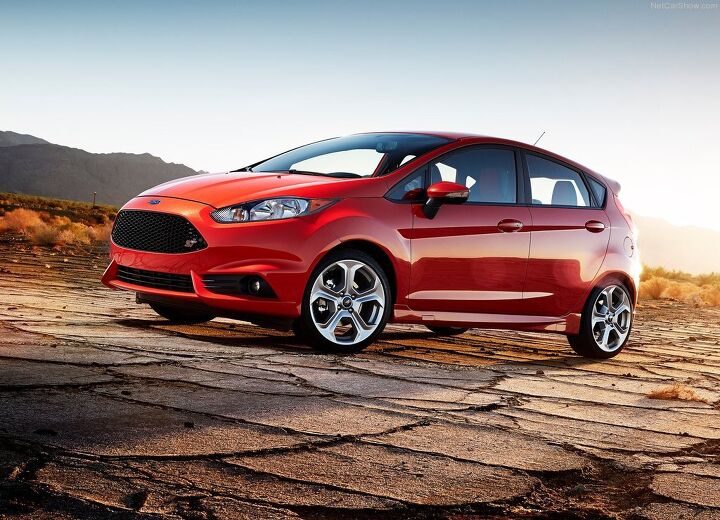


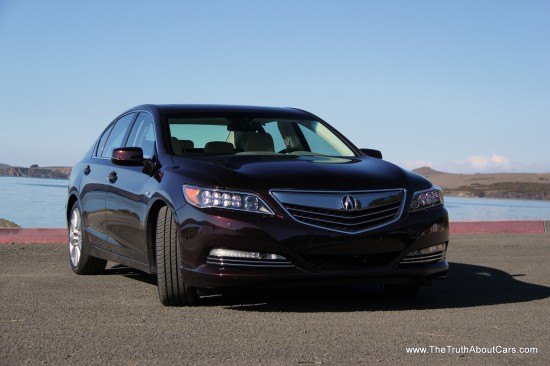


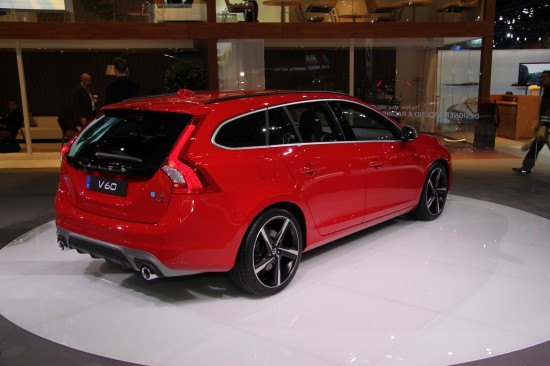


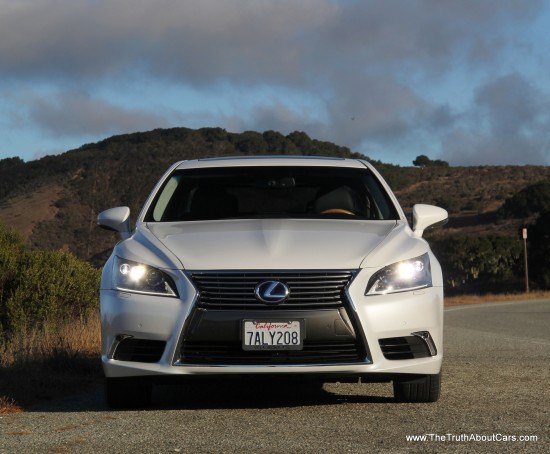
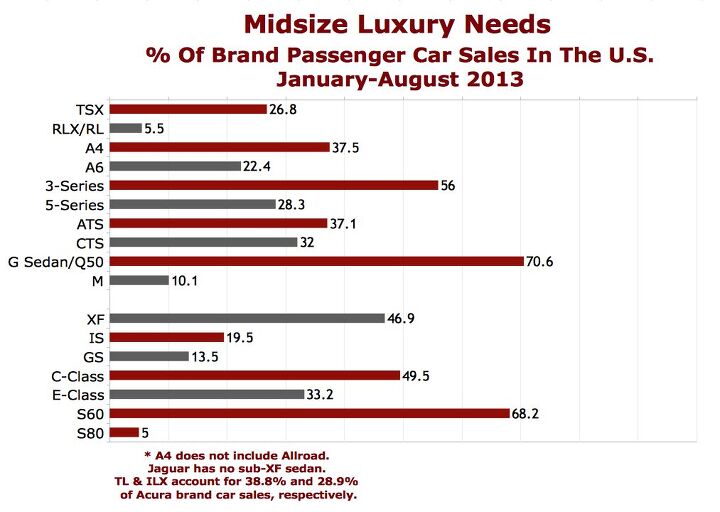












Recent Comments